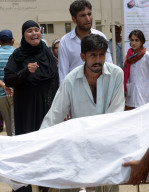
Karachi has suffered severely from the extreme heatwave that spread fast during the last week and caused over a thousand fatalities. Heatwaves are typically defined as extended periods of hotter than average temperatures, although the precise timing and temperature differential varies regionally.
Extreme heat events are one possible consequence of climate change and there is a very real possibility that the extent of the present heatwave is a result of human actions and the way Karachi is developing. It is interesting to note that while higher temperatures were documented in places such as Sukkur and Jacobabad, over 90 per cent of the deaths occurred in Karachi. Why so?
Urban settlements, due to their specific land use and development profiles, can generate unique local conditions while interacting with heat events. The most significant of such effects in the context of climate change is known as the ‘Urban Heat Island’ effect.
This phenomenon describes the warmth of the surfaces and atmosphere that urban areas often experience in comparison to the rural areas that surround them. Compared to rural areas, cities tend to have higher air and surface temperatures due to this very effect.

For the average city of one million people in a developed country, this phenomenon can cause air temperatures that are 1°C to 3°C higher than the city’s surrounding areas. At night, when the effect is at its peak, temperature differences can reach 12°C. By increasing temperatures, these urban heat island effects can aggravate the heat-related negative implications of climate change and impose costly energy demands on urban systems as they attempt to adapt to higher temperatures.
Read: Blistering heatwave: Inquiry into blackouts begins as Nawaz prepares to fly into Karachi
Karachi’s urban heat
Extreme heat events increase energy demand and affect water supply. Heatwaves are more likely to impact vulnerable populations, including the elderly, very young, individuals with pre-existing health conditions and the urban poor. The urban poor in developed countries are especially at an increased risk from extreme heat events because of their low adaptive capacity. All of this happened in the case of Karachi’s heatwave.
In Karachi, the heat generated by traffic movement, with no regulation of vehicle maintenance and the predominant use of private vehicles, air conditioning systems and industrial emissions build on the heat being radiated from the buildings and roads, further raising temperatures.
Surface temperature mapping is the best way to assess the likelihood and intensity of the phenomenon. However, the available data on land surface temperatures in Karachi is inconclusive, owing to its random nature and not being specific to determining urban heat island effect. Karachi has the potential of developing the typical temperature profile of an urban heat island, where temperatures rise from the rural fringe towards the city centre. There is a strong relationship between the density of development and intensity of the urban heat island.
Karachi’s population is expected to increase to 27.5 million by 2020. The population density within the core of the city is on the rise and is projected to increase even further in the next decade or so.
The provincial government of Sindh has recently passed the Sindh High Density Development Board Act, which sanctions the board to identify and earmark the high density zones in consultation with respective utility agencies, keeping in view the general principles of the master plan.
Read: Federal govt, K-Electric directly responsible for heat wave deaths: Memon
A high density zone is described as an area designated under the Act for the construction of high-rise buildings in the urban centres of the province. While the development of a high density zone is in itself something quite normal for a large urban settlement, the history and practice of disregarding the relevant social and environmental consequences and lack of transparency of major urban development projects in Karachi and in the province generally has made the citizens wary of the likely adverse consequences should such a plan be put into practice.
Ill-planned urban growth, disappearing green spaces and the lack of monitoring of industrial and traffic emissions are just a few critical factors contributing to the aggravating heat profile of Karachi. There is an urgent need to address these concerns as climate change and global warming are realities no one can now afford to hide from.
The writer is an urban planner and runs a non-profit organisation based in Karachi city focusing on urban sustainability issues
Published in The Express Tribune, June 29th, 2015.

















































COMMENTS
Comments are moderated and generally will be posted if they are on-topic and not abusive.
For more information, please see our Comments FAQ